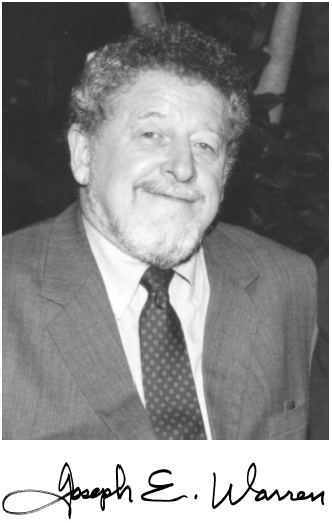
1926–2012
Elected in 1993
“For contributions to development of fractured reservoir mechanics and application of economic risk analysis.”
BY R. LYNDON ARSCOTT
JOSEPH E. WARREN, a distinguished petroleum engineer, passed away on June 16, 2012, at age 85. He served in the Navy (1943–1946) and then pursued a BS degree in petroleum engineering at the University of Pittsburgh (1951). After working for a few years at the Stanolind Oil Company in Tulsa, he continued his studies at Pennsylvania State University, where he completed his MS (1954) and PhD (1960) in petroleum engineering.
At Penn State, Joe became interested in computers in the early days of the UNIVAC II and developed numerical techniques to simulate oil and gas reservoirs. When he joined Gulf Oil Corporation’s Research and Development Company (GR&DC) in Harmarville, Pennsylvania, in 1956, he recruited and trained a digitally oriented reservoir engineering group to perform major reservoir studies and evaluations. His pioneering work in the early 1960s included water flooding, miscible displacement, in situ combustion, hydraulic fracturing, and the behavior of naturally fractured reservoirs. He published a number of papers with fellow researchers including P.J. Root, J.H. Hartsock, H.S. Price, and F.F. Skiba.
In 1963 Joe was appointed general superintendent of reservoir development for Kuwait Oil Company, with which Gulf had a contractual agreement. He evaluated operations, recommended organizational changes in oil field operations,
installed the first computer system, and discovered deeper reservoirs in the giant Burgan field based on systematic analysis of old logs. He also directed studies for a new mammoth tanker facility.
In the late 1960s he worked with G. Rowan to use statistical techniques to develop a systems approach to oil and gas operations. At the time, the oil industry was building very large crude carriers that needed carefully planned storage systems to optimize the scheduling of crude shipments. Joe developed network models for port facilities, fleet schedules, and refinery capacity in some of the world’s major oil-exporting terminals. He also published and made numerous presentations on decision analysis in exploration and production of oil and gas.
From 1966 to 1969, as director of the production division and later the exploration and production division of GR&DC, Joe was a prime supporter of an innovative R&D project that involved pumping fluid containing steel particles at high pressure (10,000 psi) to drill into deep, hard rock formations. The project solved numerous technical challenges such as the development, with Halliburton, of a pump intensifier capable of pumping abrasive, laden, viscous drilling mud up to 15,000 psi; a drilling bit and nozzles that could withstand the severe abrasion from the high-pressure abrasive fluid; and a surface separation system to separate fine formation particles from the viscous fluid. The project was field tested but did not become commercial because of the high cost; and because it was company confidential very few papers were published on the technical accomplishments.
In 1970 Joe was appointed vice president of Santa Fe International Corp. and president of Santa Fe Minerals Company, with responsibility for worldwide exploration, production, transportation, and joint venture activities. He played a leading role in the development of the Thistle Field in the UK North Sea and negotiated concession agreements in numerous countries, including Tunisia, Egypt, Cameroon, Yemen, and Burma. He also developed the “total project” concept, whereby an equity position could be secured in a newly discovered field through a package comprising
planning, project management, construction and drilling services, and financing.
After his tenure at Santa Fe, Joe consulted for Gulf Oil and many other companies on a wide range of oil and gas industry issues. He had a special aptitude for the evaluation of oil and gas fields. His sound understanding of fluid flow in porous media was combined with insightful economic reasoning and an acute ability to apply statistical analysis to estimate the value of a field and the risks involved in its development. He also had extensive experience as an expert witness and participated in a number of arbitrage hearings, as both a witness and an arbitrator.
In 1988 he cofounded and then chaired a small oil and gas company called Frontier Resources International, with interests in Africa, the Middle East, and the United States.
Joe willingly shared his knowledge through more than 50 technical papers and multiple presentations. He had a keen intellect, read widely, and loved to debate anything and everything. He was an excellent writer and started a column for the Journal of Petroleum Engineering called “In my opinion,” in which the follies of oil companies and producing countries were elegantly exposed. After each article, the staff and board members of the Society of Petroleum Engineers (SPE) would receive comments that were either enthusiastically supportive or aggressively opposed to Joe’s view. He made people think and he generated a great deal of discussion.
He was an active supporter of SPE throughout his career. He was awarded the society’s Anthony F. Lucas Gold Medal in 1984 and its highest honor, honorary membership, in 2009. He served as a distinguished lecturer and as senior technical editor of the Journal of Petroleum Technology. In 1993, he was elected to the National Academy of Engineering for his contributions to petroleum engineering.
He is survived by children Kevin and Sean Warren, Sheila Anderson, Brendan Warren, and Siobhan Foster; grandchildren Shea, Taylor, Casey, Devin, Connor, Cameron, Aidan, and Liam; and brothers Jeffrey and James Warren. His wife Lois M. predeceased him.




